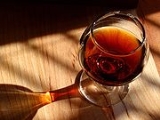
Fortified wine
Encyclopedia
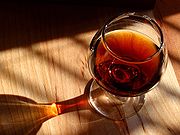
Wine
Wine is an alcoholic beverage, made of fermented fruit juice, usually from grapes. The natural chemical balance of grapes lets them ferment without the addition of sugars, acids, enzymes, or other nutrients. Grape wine is produced by fermenting crushed grapes using various types of yeast. Yeast...
to which a distilled beverage
Distilled beverage
A distilled beverage, liquor, or spirit is an alcoholic beverage containing ethanol that is produced by distilling ethanol produced by means of fermenting grain, fruit, or vegetables...
(usually brandy
Brandy
Brandy is a spirit produced by distilling wine. Brandy generally contains 35%–60% alcohol by volume and is typically taken as an after-dinner drink...
) has been added. Fortified wine is distinguished from spirits
Distilled beverage
A distilled beverage, liquor, or spirit is an alcoholic beverage containing ethanol that is produced by distilling ethanol produced by means of fermenting grain, fruit, or vegetables...
made from wine in that spirits are produced by means of distillation
Distillation
Distillation is a method of separating mixtures based on differences in volatilities of components in a boiling liquid mixture. Distillation is a unit operation, or a physical separation process, and not a chemical reaction....
, while fortified wine is simply wine that has had a spirit added to it. Many different styles of fortified wine have been developed, including port
Port wine
Port wine is a Portuguese fortified wine produced exclusively in the Douro Valley in the northern provinces of Portugal. It is typically a sweet, red wine, often served as a dessert wine, and comes in dry, semi-dry, and white varieties...
, sherry
Sherry
Sherry is a fortified wine made from white grapes that are grown near the town of Jerez , Spain. In Spanish, it is called vino de Jerez....
, madeira
Madeira wine
Madeira is a fortified Portuguese wine made in the Madeira Islands. Some wines produced in small quantities in California and Texas are also referred to as "Madeira", or "Madera", although those wines do not conform to the EU PDO regulations...
, marsala
Marsala wine
Marsala is a wine produced in the region surrounding the Italian city of Marsala in Sicily. Marsala wine first received Denominazione di Origine Controllata status in 1969....
, Commandaria wine
Commandaria
Commandaria is an amber-coloured sweet dessert wine made in the Commandaria region of Cyprus on the foothills of the Troödos mountains. Commandaria is made from sun-dried grapes of the varieties Xynisteri and Mavro. While often a fortified wine, through its production method it often reaches high...
and vermouth
Vermouth
Vermouth is a fortified wine flavored with various dry ingredients. The modern versions of the beverage were first produced around the late 18th and early 19th centuries in Italy and France...
.
Production
The original reason for fortifying wine was to preserve it, since ethanolEthanol
Ethanol, also called ethyl alcohol, pure alcohol, grain alcohol, or drinking alcohol, is a volatile, flammable, colorless liquid. It is a psychoactive drug and one of the oldest recreational drugs. Best known as the type of alcohol found in alcoholic beverages, it is also used in thermometers, as a...
is a natural antiseptic
Antiseptic
Antiseptics are antimicrobial substances that are applied to living tissue/skin to reduce the possibility of infection, sepsis, or putrefaction...
. Even though other preservation methods now exist, fortification continues to be used because the process can add distinct flavors to the finished product.
Although grape brandy is most commonly added to produce fortified wines, the additional alcohol may also be neutral spirit
Neutral grain spirit
Neutral grain spirit is a clear, colorless, flammable liquid that has been distilled from a grain-based mash to a very high level of ethanol content...
that has been distilled from grapes, grain, sugar beet
Sugar beet
Sugar beet, a cultivated plant of Beta vulgaris, is a plant whose tuber contains a high concentration of sucrose. It is grown commercially for sugar production. Sugar beets and other B...
s, or sugarcane
Sugarcane
Sugarcane refers to any of six to 37 species of tall perennial grasses of the genus Saccharum . Native to the warm temperate to tropical regions of South Asia, they have stout, jointed, fibrous stalks that are rich in sugar, and measure two to six metres tall...
. Regional appellation
Appellation
An appellation is a legally defined and protected geographical indication used to identify where the grapes for a wine were grown; other types of food often have appellations as well...
laws may dictate the types of spirit that are permitted for fortification.
The source of the additional alcohol and the method of its distillation can affect the flavor of the fortified wine. If neutral spirit
Neutral grain spirit
Neutral grain spirit is a clear, colorless, flammable liquid that has been distilled from a grain-based mash to a very high level of ethanol content...
is used, it will usually have been produced with a continuous still, rather than a pot still
Pot still
A pot still is a type of still used in distilling spirits such as whisky or brandy. Heat is applied directly to the pot containing the wash or wine . This is called a batch distillation ....
.
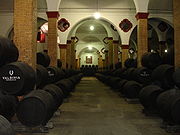
Fermentation (wine)
The process of fermentation in wine turns grape juice into an alcoholic beverage. During fermentation, yeast interact with sugars in the juice to create ethanol, commonly known as ethyl alcohol, and carbon dioxide...
process is complete, the alcohol in the distilled beverage kills the yeast
Yeast
Yeasts are eukaryotic micro-organisms classified in the kingdom Fungi, with 1,500 species currently described estimated to be only 1% of all fungal species. Most reproduce asexually by mitosis, and many do so by an asymmetric division process called budding...
and leaves residual sugar behind. The end result is a wine that is both sweeter and stronger, normally containing about 20% alcohol by volume
Alcohol by volume
Alcohol by volume is a standard measure of how much alcohol is contained in an alcoholic beverage .The ABV standard is used worldwide....
(ABV).
During the fermentation
Ethanol fermentation
Ethanol fermentation, also referred to as alcoholic fermentation, is a biological process in which sugars such as glucose, fructose, and sucrose are converted into cellular energy and thereby produce ethanol and carbon dioxide as metabolic waste products...
process, yeast cells in the must
Must
Must is freshly pressed fruit juice that contains the skins, seeds, and stems of the fruit. The solid portion of the must is called pomace; it typically makes up 7%–23% of the total weight of the must. Making must is the first step in winemaking...
continue to convert sugar into alcohol until the must reaches an alcohol level of 16%–18%. At this level, the alcohol becomes toxic
Toxin
A toxin is a poisonous substance produced within living cells or organisms; man-made substances created by artificial processes are thus excluded...
to the yeast and kills it. If fermentation is allowed to run to completion, the resulting wine will (in most cases) be low in sugar and will be considered a dry wine. The earlier in the fermentation process that alcohol is added, the sweeter the resulting wine will be. For drier fortified wine styles, such as sherry
Sherry
Sherry is a fortified wine made from white grapes that are grown near the town of Jerez , Spain. In Spanish, it is called vino de Jerez....
, the alcohol is added shortly before or after the end of the fermentation.
In the case of some fortified wine styles (such as late harvest
Late harvest wine
Late harvest is a term applied to wines made from grapes left on the vine longer than usual. Late harvest is usually an indication of a sweet dessert wine, such as late harvest Riesling. Late harvest grapes are often more similar to raisins, but have been naturally dehydrated while on the vine...
and botrytized wine
Noble rot
Noble rot is the benevolent form of a grey fungus, Botrytis cinerea, affecting wine grapes. Infestation by Botrytis requires moist conditions, and if the weather stays wet, the malevolent form, "grey rot", can destroy crops of grapes...
s), a naturally high level of sugar will inhibit the yeast. This causes fermentation to stop before the wine can become dry.
Mistelle
Mistelle ' onMouseout='HidePop("93353")' href="/topics/Spanish_language">SpanishSpanish language
Spanish , also known as Castilian , is a Romance language in the Ibero-Romance group that evolved from several languages and dialects in central-northern Iberia around the 9th century and gradually spread with the expansion of the Kingdom of Castile into central and southern Iberia during the...
, Portuguese
Portuguese language
Portuguese is a Romance language that arose in the medieval Kingdom of Galicia, nowadays Galicia and Northern Portugal. The southern part of the Kingdom of Galicia became independent as the County of Portugal in 1095...
, Galician
Galician language
Galician is a language of the Western Ibero-Romance branch, spoken in Galicia, an autonomous community located in northwestern Spain, where it is co-official with Castilian Spanish, as well as in border zones of the neighbouring territories of Asturias and Castile and León.Modern Galician and...
and , from Latin / "mix") is sometimes used as an ingredient in fortified wines, particularly Vermouth
Vermouth
Vermouth is a fortified wine flavored with various dry ingredients. The modern versions of the beverage were first produced around the late 18th and early 19th centuries in Italy and France...
, Marsala
Marsala wine
Marsala is a wine produced in the region surrounding the Italian city of Marsala in Sicily. Marsala wine first received Denominazione di Origine Controllata status in 1969....
and Sherry
Sherry
Sherry is a fortified wine made from white grapes that are grown near the town of Jerez , Spain. In Spanish, it is called vino de Jerez....
, though it is used mainly as a base for apéritif
Aperitif
Apéritifs and digestifs are alcoholic drinks that are normally served with meals.-Apéritifs:An apéritif is usually served before a meal to stimulate the appetite. This contrasts with digestifs, which are served after a meal for the purpose of aiding digestion...
s such as the French Pineau des Charentes
Pineau des Charentes
Pineau des Charentes, is a regional French aperitif, made in the départements of Charente, Charente-Maritime and, to a much lesser extent, Dordogne in western France...
. It is produced by adding alcohol to non-fermented or partially fermented
Fermentation (food)
Fermentation in food processing typically is the conversion of carbohydrates to alcohols and carbon dioxide or organic acids using yeasts, bacteria, or a combination thereof, under anaerobic conditions. Fermentation in simple terms is the chemical conversion of sugars into ethanol...
grape juice. The addition of alcohol stops the fermentation and, as a consequence Mistelle is sweeter than fully fermented grape juice in which the sugars turn to alcohol.
Varieties
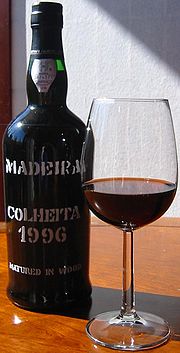
Madeira wine
Madeira is a fortified wine made in the Madeira Islands. The wine is produced in a variety of styles ranging from dry wines which can be consumed on their own as an aperitifAperitif
Apéritifs and digestifs are alcoholic drinks that are normally served with meals.-Apéritifs:An apéritif is usually served before a meal to stimulate the appetite. This contrasts with digestifs, which are served after a meal for the purpose of aiding digestion...
, to sweet wines more usually consumed with dessert
Dessert
In cultures around the world, dessert is a course that typically comes at the end of a meal, usually consisting of sweet food. The word comes from the French language as dessert and this from Old French desservir, "to clear the table" and "to serve." Common Western desserts include cakes, biscuits,...
.
Marsala wine
Marsala wine is a wine from SicilySicily
Sicily is a region of Italy, and is the largest island in the Mediterranean Sea. Along with the surrounding minor islands, it constitutes an autonomous region of Italy, the Regione Autonoma Siciliana Sicily has a rich and unique culture, especially with regard to the arts, music, literature,...
that is available in both fortified and unfortified versions. It was first produced in 1772 by an English merchant, John Woodhouse, as an inexpensive substitute for sherry and port, and gets its name from the island's port, Marsala
Marsala
Marsala is a seaport city located in the Province of Trapani on the island of Sicily in Italy. The low coast on which it is situated is the westernmost point of the island...
. The fortified version is blended with brandy
Brandy
Brandy is a spirit produced by distilling wine. Brandy generally contains 35%–60% alcohol by volume and is typically taken as an after-dinner drink...
to make two styles, the younger, slightly weaker Fine, which is at least 17% abv
ABV
ABV is a three-letter acronym that may refer to:* Alcohol by volume, a measure of the alcohol content of alcoholic drinks* Nnamdi Azikiwe International Airport, Abuja, Nigeria, from its IATA airport code...
and aged at least four months; and the Superiore, which is at least 18%, and aged at least two years. The unfortified Marsala wine is aged in wooden casks for five years or more and reaches a strength of 18% by evaporation
Evaporation
Evaporation is a type of vaporization of a liquid that occurs only on the surface of a liquid. The other type of vaporization is boiling, which, instead, occurs on the entire mass of the liquid....
.
Port wine
Port wine (also known simply as Port) is a fortified wine from the Douro ValleyDouro
The Douro or Duero is one of the major rivers of the Iberian Peninsula, flowing from its source near Duruelo de la Sierra in Soria Province across northern-central Spain and Portugal to its outlet at Porto...
in the northern provinces of Portugal
Portugal
Portugal , officially the Portuguese Republic is a country situated in southwestern Europe on the Iberian Peninsula. Portugal is the westernmost country of Europe, and is bordered by the Atlantic Ocean to the West and South and by Spain to the North and East. The Atlantic archipelagos of the...
. It is typically a sweet red wine, but also comes in dry, semi-dry and white varieties.
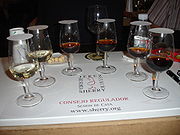
Sherry
Sherry is a fortified wine made from white grapes that are grown near the town of JerezJerez de la Frontera
Jerez de la Frontera is a municipality in the province of Cádiz in the autonomous community of Andalusia, in southwestern Spain, situated midway between the sea and the mountains. , the city, the largest in the province, had 208,896 inhabitants; it is the fifth largest in Andalusia...
, Spain
Spain
Spain , officially the Kingdom of Spain languages]] under the European Charter for Regional or Minority Languages. In each of these, Spain's official name is as follows:;;;;;;), is a country and member state of the European Union located in southwestern Europe on the Iberian Peninsula...
. The word "sherry" is an anglicization of Jerez. In earlier times, sherry was known as sack
Sack (wine)
Sack is an antiquated wine term referring to white fortified wine imported from mainland Spain or the Canary Islands. There were sack of different origins such as:* Canary sack from the Canary Islands,* Malaga sack from Málaga,...
(from the Spanish saca, meaning "a removal from the solera
Solera
Solera is a process for aging liquids such as wine, beer, vinegar, and brandy, by fractional blending in such a way that the finished product is a mixture of ages, with the average age gradually increasing as the process continues over many years. A solera is literally the set of barrels or other...
"). In the European Union "sherry" is a protected designation of origin
Protected designation of origin
Protected Geographical Status is a legal framework defined in European Union law to protect the names of regional foods. Protected Designation of Origin , Protected Geographical Indication and Traditional Speciality Guaranteed are distinct regimes of geographical indications within the framework...
; therefore, all wine labeled as "sherry" must legally come from the Sherry Triangle, which is an area in the province of Cádiz
Cádiz (province)
Cádiz is a province of southern Spain, in the southwestern part of the autonomous community of Andalusia, the southernmost part of continental Western Europe....
between Jerez de la Frontera
Jerez de la Frontera
Jerez de la Frontera is a municipality in the province of Cádiz in the autonomous community of Andalusia, in southwestern Spain, situated midway between the sea and the mountains. , the city, the largest in the province, had 208,896 inhabitants; it is the fifth largest in Andalusia...
, Sanlúcar de Barrameda
Sanlúcar de Barrameda
Sanlúcar de Barrameda is a city in the northwest of Cádiz province, part of the autonomous community of Andalucía in southern Spain. Sanlúcar is located on the left bank at the mouth of the Guadalquivir River opposite the Doñana National Park, 52 km from the provincial capital Cádiz and...
, and El Puerto de Santa María
El Puerto de Santa María
El Puerto de Santa María is a municipality located on the banks of the Guadalete River in the province of Cádiz, Spain. , the city has a population of c...
.
After fermentation
Fermentation (wine)
The process of fermentation in wine turns grape juice into an alcoholic beverage. During fermentation, yeast interact with sugars in the juice to create ethanol, commonly known as ethyl alcohol, and carbon dioxide...
is complete, sherry is fortified with brandy
Brandy
Brandy is a spirit produced by distilling wine. Brandy generally contains 35%–60% alcohol by volume and is typically taken as an after-dinner drink...
. Because the fortification takes place after fermentation, most sherries are initially dry, with any sweetness being added later. In contrast, port wine
Port wine
Port wine is a Portuguese fortified wine produced exclusively in the Douro Valley in the northern provinces of Portugal. It is typically a sweet, red wine, often served as a dessert wine, and comes in dry, semi-dry, and white varieties...
(for example) is fortified halfway through its fermentation, which stops the process so that not all of the sugar is turned into alcohol.
Sherry is produced in a variety of styles, ranging from dry, light versions such as fino
Fino
Fino is the driest and palest of the traditional varieties of sherry. They are drunk comparatively young, and unlike the sweeter varieties should be drunk soon after the bottle is opened as exposure to air can cause them to lose their flavour within hours.-Flor:The defining component of Fino...
s to much darker and sometimes sweeter versions known as oloroso
Oloroso
Oloroso is a variety of sherry produced by oxidative aging. It is normally darker than amontillado and has a higher glycerine content, which makes it smoother and less dry. Oloroso is usually dark and nutty....
s.
Vermouth
Vermouth is a fortified wine flavored with aromatic herbHerb
Except in botanical usage, an herb is "any plant with leaves, seeds, or flowers used for flavoring, food, medicine, or perfume" or "a part of such a plant as used in cooking"...
s and spice
Spice
A spice is a dried seed, fruit, root, bark, or vegetative substance used in nutritionally insignificant quantities as a food additive for flavor, color, or as a preservative that kills harmful bacteria or prevents their growth. It may be used to flavour a dish or to hide other flavours...
s ("aromatized" in the trade) using closely guarded recipes (trade secret
Trade secret
A trade secret is a formula, practice, process, design, instrument, pattern, or compilation of information which is not generally known or reasonably ascertainable, by which a business can obtain an economic advantage over competitors or customers...
s). Some of the herbs and spices used may include cardamom
Cardamom
Cardamom refers to several plants of the genera Elettaria and Amomum in the ginger family Zingiberaceae. Both genera are native to India and Bhutan; they are recognised by their small seed pod, triangular in cross-section and spindle-shaped, with a thin papery outer shell and small black seeds...
, cinnamon
Cinnamon
Cinnamon is a spice obtained from the inner bark of several trees from the genus Cinnamomum that is used in both sweet and savoury foods...
, marjoram
Marjoram
Marjoram is a somewhat cold-sensitive perennial herb or undershrub with sweet pine and citrus flavours...
and chamomile
Chamomile
Chamomile or camomile is a common name for several daisy-like plants of the family Asteraceae. These plants are best known for their ability to be made into an infusion which is commonly used to help with sleep and is often served with either honey or lemon. Because chamomile can cause uterine...
. Some vermouth is sweetened; however, unsweetened, or dry, vermouth tends to be bitter. The person credited with the second vermouth recipe, Antonio Benedetto Carpano
Antonio Benedetto Carpano
Antonio Benedetto Carpano was an Italian distiller, famous for having invented Vermouth and consequently the apéritif....
from Turin
Turin
Turin is a city and major business and cultural centre in northern Italy, capital of the Piedmont region, located mainly on the left bank of the Po River and surrounded by the Alpine arch. The population of the city proper is 909,193 while the population of the urban area is estimated by Eurostat...
, Italy
Italy
Italy , officially the Italian Republic languages]] under the European Charter for Regional or Minority Languages. In each of these, Italy's official name is as follows:;;;;;;;;), is a unitary parliamentary republic in South-Central Europe. To the north it borders France, Switzerland, Austria and...
, chose to name his concoction "vermouth" in 1786 because he was inspired by a German
Germany
Germany , officially the Federal Republic of Germany , is a federal parliamentary republic in Europe. The country consists of 16 states while the capital and largest city is Berlin. Germany covers an area of 357,021 km2 and has a largely temperate seasonal climate...
wine flavoured with wormwood
Artemisia absinthium
Artemisia absinthium is a species of wormwood, native to temperate regions of Eurasia and northern Africa....
, a herb most famously used in distilling absinthe
Absinthe
Absinthe is historically described as a distilled, highly alcoholic beverage. It is an anise-flavoured spirit derived from herbs, including the flowers and leaves of the herb Artemisia absinthium, commonly referred to as "grande wormwood", together with green anise and sweet fennel...
. However, wine flavored with wormwood goes back to ancient Rome. The modern German word Wermut (Wermuth in the spelling of Carpano's time) means both wormwood and vermouth. The herbs were originally used to mask raw flavors of cheaper wines, imparting a slightly medicinal "tonic" flavour.
Vins doux naturels
Vins doux naturels are lightly fortified wines typically made from white MuscatMuscat (grape and wine)
The Muscat variety of grapes of the species Vitis vinifera is widely grown for wine, raisins and table grapes. Their color ranges from white to near black. Muscat almost always has a pronounced sweet floral aroma. Muscat grapes are grown around the world...
grapes or red Grenache
Grenache
Grenache is one of the most widely planted red wine grape varieties in the world. It ripens late, so it needs hot, dry conditions such as those found in Spain, the south of France, and California's San Joaquin Valley. It is generally spicy, berry-flavored and soft on the palate with a relatively...
grapes in the south of France
France
The French Republic , The French Republic , The French Republic , (commonly known as France , is a unitary semi-presidential republic in Western Europe with several overseas territories and islands located on other continents and in the Indian, Pacific, and Atlantic oceans. Metropolitan France...
. The production of vins doux naturels was perfected by Arnaud de Villeneuve at the University of Montpellier
University of Montpellier
The University of Montpellier was a French university in Montpellier in the Languedoc-Roussillon région of the south of France. Its present-day successor universities are the University of Montpellier 1, Montpellier 2 University and Paul Valéry University, Montpellier III.-History:The university...
in the 13th century and they are now quite common in the Languedoc-Roussillon
Languedoc-Roussillon
Languedoc-Roussillon is one of the 27 regions of France. It comprises five departments, and borders the other French regions of Provence-Alpes-Côte d'Azur, Rhône-Alpes, Auvergne, Midi-Pyrénées on the one side, and Spain, Andorra and the Mediterranean sea on the other side.-Geography:The region is...
of southwest France.
As the name suggests, Muscat de Beaumes-de-Venise, Muscat de Rivesaltes
Muscat de Rivesaltes AOC
Muscat de Rivesaltes is an Appellation d'Origine Contrôlée for fortified wines made in the Roussillon wine region of France. They are similar to Rivesaltes AOC wines, except for the grape varieties used...
, and Muscat de Frontignan are all made from the white Muscat grape, whilst Banyuls
Banyuls AOC
Banyuls is a French appellation d'origine contrôlée for a fortified apéritif or dessert wine made from old vines cultivated in terraces on the slopes of the Catalan Pyrenees in the Roussillon county of France, bordering, to the south, the Empordà wine region in Catalonia in Spain.The AOC...
and Maury
Maury AOC
Maury is an Appellation d'Origine Contrôlée for wines made in the Roussillon wine region of France. Almost all wines are red, made from at least 75% Grenache Noir grapes. Other permitted grapes are Grenache Blanc, Grenache Gris, and Macabeu, Malvoisie and Muscat. Maury is well-known for its sweet,...
are made from red Grenache
Grenache
Grenache is one of the most widely planted red wine grape varieties in the world. It ripens late, so it needs hot, dry conditions such as those found in Spain, the south of France, and California's San Joaquin Valley. It is generally spicy, berry-flavored and soft on the palate with a relatively...
. Regardless of the grape, fermentation is stopped by the addition of up to 10% of a 190 proof
Proof (alcohol)
Alcohol proof is a measure of how much alcohol is contained in an alcoholic beverage. The term was originally used in the United Kingdom and was defined as 7/4 times the alcohol by volume . The UK now uses the abv standard instead of alcohol proof. In the United States, alcoholic proof is defined...
(95%) grape spirit. The Muscats are made in a somewhat oxidised style, the Grenaches less so.
Low-end fortified wines
Inexpensive fortified wines, such as Thunderbird and Wild Irish Rose, became popular during the Great DepressionGreat Depression
The Great Depression was a severe worldwide economic depression in the decade preceding World War II. The timing of the Great Depression varied across nations, but in most countries it started in about 1929 and lasted until the late 1930s or early 1940s...
for their relatively high alcohol content. The term wino
Wino
Wino is a slang term for a person, especially one who is homeless, who consumes large amounts of alcohol, usually in the form of low-end fortified wineWino may also refer to:* Wino , a subatomic particle...
was coined during this period to describe impoverished people who drank these wines solely for their inebriating effect.
These wines continue to be associated with the homeless, mainly because marketers have been aggressive in targeting low-income communities as ideal consumers of these beverages; organizations in cities such as Los Angeles, San Francisco, Seattle, and Portland have urged makers of inexpensive fortified wine, including E & J Gallo Winery
E & J Gallo Winery
E & J Gallo Winery was founded in 1933 by Ernest Gallo and Julio Gallo in Modesto, California. E & J Gallo Winery is the largest exporter of California wines and is a large promoter of wines from Sonoma County.-History:...
, to stop providing such products to liquor stores in impoverished areas. In 2005, the Seattle City Council asked the Washington State Liquor Control Board
Washington State Liquor Control Board
The Washington State Liquor Control Board is an administrative agency of the State of Washington. The Liquor Control Board is part of the executive branch and reports to the Governor. The Board holds a monopoly on the distribution of hard liquor because Washington is a control state...
to prohibit the sale of certain alcohol products in an impoverished "Alcohol Impact Area." Among the products sought to be banned were over two dozen beers, and six fortified wines: Cisco, Gino's Premium Blend, MD 20/20, Night Train, Thunderbird, and Wild Irish Rose. The Liquor Control Board approved these restrictions on August 30, 2006.
Terminology
Fortified wines are often termed dessert wineDessert wine
Dessert wines are sweet wines typically served with dessert.There is no simple definition of a dessert wine. In the UK, a dessert wine is considered to be any sweet wine drunk with a meal, as opposed to the white fortified wines drunk before the meal, and the red fortified wines drunk after it...
s in the United States
United States
The United States of America is a federal constitutional republic comprising fifty states and a federal district...
to avoid association with hard drinking. The term "Vins de liqueur
Vins de liqueur
A vin de liqueur is a sweet fortified style of French wine that is fortified with brandy just prior to fermentation. The term vin de liqueur is also used by the European Union to refer to all fortified wines....
" is used by the French. Under European Union
European Union
The European Union is an economic and political union of 27 independent member states which are located primarily in Europe. The EU traces its origins from the European Coal and Steel Community and the European Economic Community , formed by six countries in 1958...
legislation, a liqueur wine is a fortified wine that contains not less than 17.5% abv
ABV
ABV is a three-letter acronym that may refer to:* Alcohol by volume, a measure of the alcohol content of alcoholic drinks* Nnamdi Azikiwe International Airport, Abuja, Nigeria, from its IATA airport code...
(except for certain quality liqueur wines) and that meets many additional criteria.
External links
- Fortified Wines- A description.
- Dessert Wines — Fortified Wine Production.

